
by Lyn Collingwood, Bulletin 5/2009, June 2009
Rozelle Tramway Car Depot was opened in April 1904 with a capacity to house 200 electric tramcars and some 400 personnel. By the 1930s, when Sydney’s tram system was second in size in the British Empire only to London’s, the depot provided services for the Balmain, Leichhardt, Abbotsford, Lilyfield and Birchgrove lines. Glebe Point trams were serviced at the Newtown Depot, adjacent to Newtown railway station and, like Rozelle, now derelict.
Rozelle was the seventh of Sydney’s depots to come into operation, following Ridge Street, North Sydney (1893), Rushcutters Bay (1898), Ultimo (1899), Newtown (1900), Waverley (1902) and Fort Macquarie (1902). Leichhardt Depot, which opened in 1915, was used to store surplus tramcars.
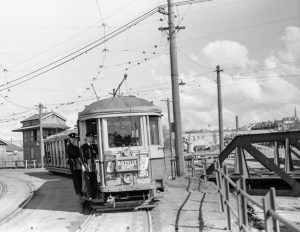
The Balmain tramline was built to run down Ross St and Crescent Street, across swamps and Johnston’s Creek via a truss bridge, past a line of mangroves along Rozelle Bay and up ‘Rozelle Hill’. For decades crowds of punters were transported by ‘raceday specials’ (powered by steam, then electricity) to the local racecourse, known in turn as Little Bridge, Epping and Harold Park.
The NSW Harness Racing Club now owns Harold Park, including the depot which closed in November 1958. By March 1959 there were reports of vandalism but the sheds remained reasonably damage-free until the year 2000. Since then, the trams still on-site have been repeatedly smashed and the complex covered in graffiti. The war memorial, one of several erected by NSW Government Tramways, has disappeared and there is no trace of the beautifully maintained garden in which it stood.
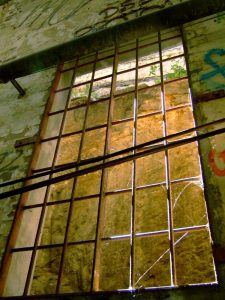
Sydney’s first trams, horse-drawn, ran 1861-6 from Circular Quay to the rail terminus at Redfern. A fleet of steam trams, used by visitors to the 1879 International Exhibition, was expanded – steam services to Forest Lodge and Glebe Point began in August 1882. The trip to the city, via Elizabeth Street, took about 25 minutes. Electricity replaced steam on the Glebe Point run from January 1901 and on the line to Forest Lodge from August 1902. Both services now ran along George Street. Because of the steep gradient at Rozelle Bay the Glebe Point terminus was fixed at Leichhardt Street. A 1912 proposal to extend the track down Eglinton Road and through Rozelle Depot to join the Balmain line was rejected as conveniencing only a few and bringing in little revenue. A signal box at the City Road junction controlled the Newtown, Glebe Point and Balmain (via Derwent Street) lines.
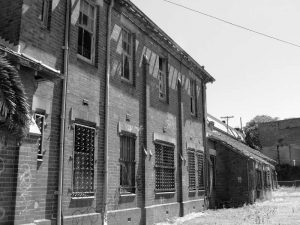
In late 1903 there was a flurry of activity within Government Tramways as men and rolling stock were organised for relocation to Rozelle Depot. Conductors and drivers were transferred from Newtown, Waverley, Ultimo and Fort Macquarie depots. James A Steel, who lived at 37 Campbell Street Glebe, asked for a transfer from Waverley to be closer to home. Furniture and stock were ordered: Austrian chairs, cedar tables, wash jugs and basins, cash boxes, conductors’ badges and bags, ticket cases, drivers’ watches (although they were expected to note the time from public clocks installed at the Quay and Central Railway) and a revolver (not issued). On the night of 16 April 1904, a Saturday, 77 single and seven coupled cars were sent across. An emergency breakdown car was installed, ready to deal with a derailment or major accident.
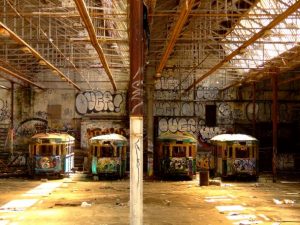
The 1904 Rozelle workforce included depot master Henry J Mark, senior clerk J C White, ledger and receiving clerks John O’Connor, R Crawford, R Barnes, B F Weatherstone, W W Wirrell and Henry W Chinchin. Office boy and junior clerk was Thomas M Emery who had trouble learning the telephone switchboard. C Parnell and Thomas F Ryan were the depot’s first shedmen, John Long and James Gower its first signalmen. Each allocated £1 in change per shift, 207 conductors (including E Faircloff, H S Henry and H E Wright transferred from Fort Macquarie) had to fiddle with halfpennies, deal with newsboys and basket-carrying hawkers jumping onto the cars, passengers expectorating and putting their feet on the seats, and tickets blowing onto the road – the City Council charged a litter fee. Oliver Collins, Robert Barber, Edward Gosnell, Francis Greenhalgh, Rudolph Bernhardt, William Avery and Alfred Mulligan were employed to clean the trams. ‘The new institution’, wrote the Daily Telegraph, ‘is a great improvement to the general appearance of the surrounding locality.’ Camaraderie among tramway employees was reinforced by the provision of staff amenities. By 1916, facilities at the Rozelle Tramway Depot Recreation Club included a billiard room (heavily used), a library, a hall for social activities and an outdoor miniature rifle range. ‘Fostering all kinds of manly sports’, its colours maroon and white, the club was open until 11pm on weekdays and 6pm on Saturdays. Employees paid two shillings to join then threepence weekly. Alcohol and gambling were prohibited. In 1921 the recreation building was enlarged. Mr Haggerwood was paid sixpence per tin by Balmain Council to remove garbage generated by the meal room. Activities of the Tramway Officers’ Social and Educational Club, formed in 1927, included cricket, smoke concerts, visits to factories and lantern slide evenings in the tramway instruction room at the Ultimo Power House.
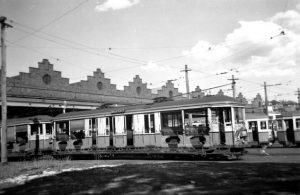
Staff doings were reported in the railway and tramway journal The Staff. Praised in 1930 was Rozelle driver Charles Perry who resuscitated a boy who had fallen into a canal. A regular column was devoted to gardening. Rozelle Tramway Depot was judged winner of the Champion Garden contest in 1928. Exposed to the weather and passing traffic as they balanced on external footboards to collect fares, conductors were in constant danger of falling ill or falling off. The NSW Government Tramway Band – including the Rozelle Depot Band – led funeral processions of dead colleagues to the Mortuary Station where they played ‘Lead Kindly Light’. The Tramway Sick and Accident Company, formed in 1884, covered sickness and funeral expenses.
Rozelle Depot closed on 22 November 1958, a Saturday. The first bus to Glebe Point ran at 12.20am the next morning and the first to Balmain at 12.30am. In the city overhead wiring and tram tracks were hastily removed. Tramcars were taken to the Randwick workshops where they were burnt at the rate of 12 a week. Replacement of trams with ‘one-man’ buses had for years been given the ‘highest priority’ by Alfred Shoebridge, the Commissioner for Government Transport under the Cahill Labor Government, grappling with increasing traffic congestion and private car use. Many condemned the loss of the trams as short-sighted and bus drivers disliked the one-man system. Shoebridge had 600 striking drivers dismissed in 1955.
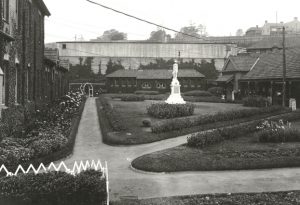
Removal of the tram tracks along Glebe Point Road was delayed because of haggling by the City of Sydney and the Department of Government Transport over who should pay. The dispute was resolved by 1966, the Council accepting responsibility for any claims arising from exposed rails in return for the costs (totalling £45 600) being split. The track embedded in concrete east of Bridge Road was contracted to be dug up and that from Bridge Road to the terminus at Leichhardt Street asphalted over. During the recent Glebe Point Road renovations tracks found at the eastern end were removed. In 1966, the City of Sydney bought the A V Henry Playground site, which it had leased in 1961, and the Rozelle Tramway Depot Substation.
Apart from the Rozelle tramsheds, little evidence remains in Glebe of the huge tram network which once spread across Sydney from La Perouse to Watsons Bay, from Ryde to Brighton-le-Sands. The bus shelter outside the Woolcock building, 431 Glebe Point Road, was originally a tramway waiting shed. It was built in 1938 to replace a starter’s cabin, dismantled and sent to Wolli Creek Depot in exchange for a kerbside bubbler for tram staff use. Glebe Council, who footed the £50 bill, criticised the contractor for slipshod work using poor concrete and too few coats of paint and predicted the structure would not last.
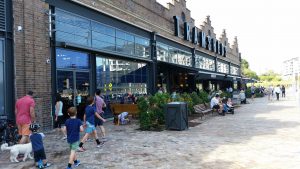
Update July 2022: A year after this article was written, the Rozelle Tram Depot was acquired by Mirvac and re-adapted as Tramsheds, officially opened in 2016. In 2018, the restored World War 1 statue of a digger was replaced close to its original position beside the Tramsheds.
Major Sources:
- C Butler-Bowden Shooting through 2009
- Daily Telegraph 20 April 1904
- John H Forsyth Tramway history card notes 1976
- David Keenan Tramways of Sydney 1979
- NSW Railway & Tramway Commissioners The Staff various issues 1929-30
- Railway Institute Council NSW Railway Budget Jubilee issue 7 October 1905
- State Records Authority of NSW sport files 8/1400, 8/1439, 8/1492, 8//1541,8/1548, 8/1576, 10/30588









5 comments. Please add yours.
The current Anzac man is not in his original spot. The photographs confirm it
I wish they would build another garden exactly the same with the Rozelle imprinted on it . They have spent so much on the park. There gardens at Tramsheds however they are just there and nothing else. THEY SHOULD PUT THE ANZAC MAN OUT WHERE YOU CAN SEE HIM. He deserves a lovely garden around him.
The Anzac man is standing in the best spot in these original photos.
Apparently he was restored and with Clover Moore in attendance was said to have been placed in his original spot.
THE ORIGINAL SPOT IS NOT WHERE HE STANDS TODAY.
He is shoved up against a wall overshadowed by a restaurant with NO GARDEN AT ALL.
No one seems to care any more.
I DO
They should put the Anzac man out where everyone can see him. He is shoved up against a wall. So many gardens and flowers and you can hardly even see the Anzac. He had a lovely spot in the original garden. I find this a real slap in the face to past war veterans.
This was very informative. I only knew of Newton Tram Depot. I didn’t know there was another one. I’ve lived in Sydney from the age of 4. We had trams running down the end of our street past the Yeast. Works in Croydon Park. When I went into the City from Burwood station. I saw some of the Trams being taken out on a big truck. I wondered what they were going to do with the land. In all this time I never knew, until my daughter booked a family table for Easter Sunday at the “ TRAMS SHEDS ”
It’s very sad that sydney has lost so much of it’s heritage. I personally think that sydney has been raped and destroyed . So much of the past is gone forever. I personally believe it’s been deliberate and goverments don’t seen too care.Or the goverments care about is developement smash this wreck that.I cry sometimes about this as sydney had so much beauty.And to think that 12 trams were being burnt every week at the former randwick workshops makes me sick .I have seen the photo’s on the internet so many politians from the past and present have really been destuctive and cruel to this place we call sydney.